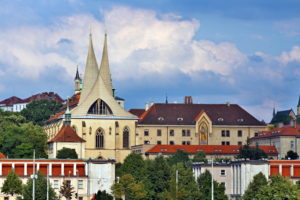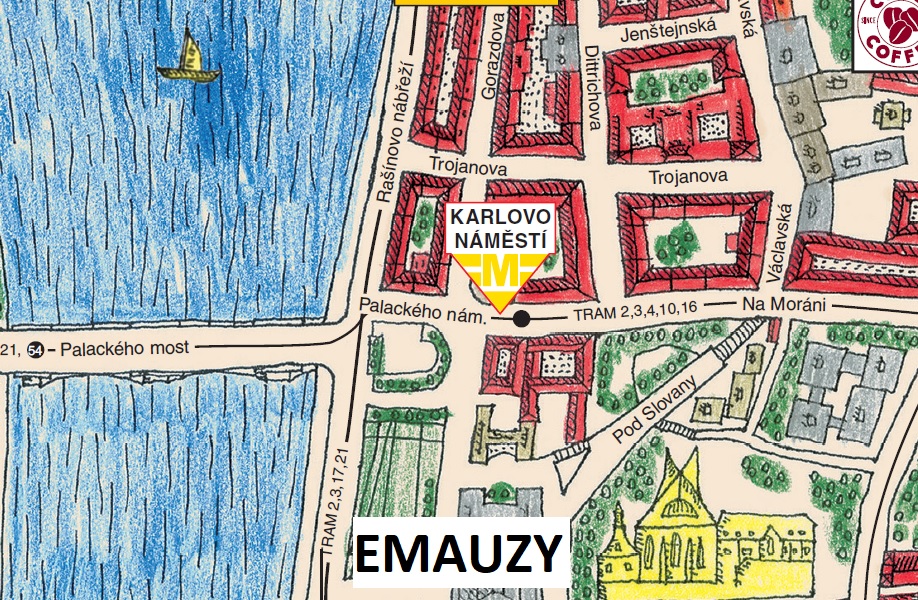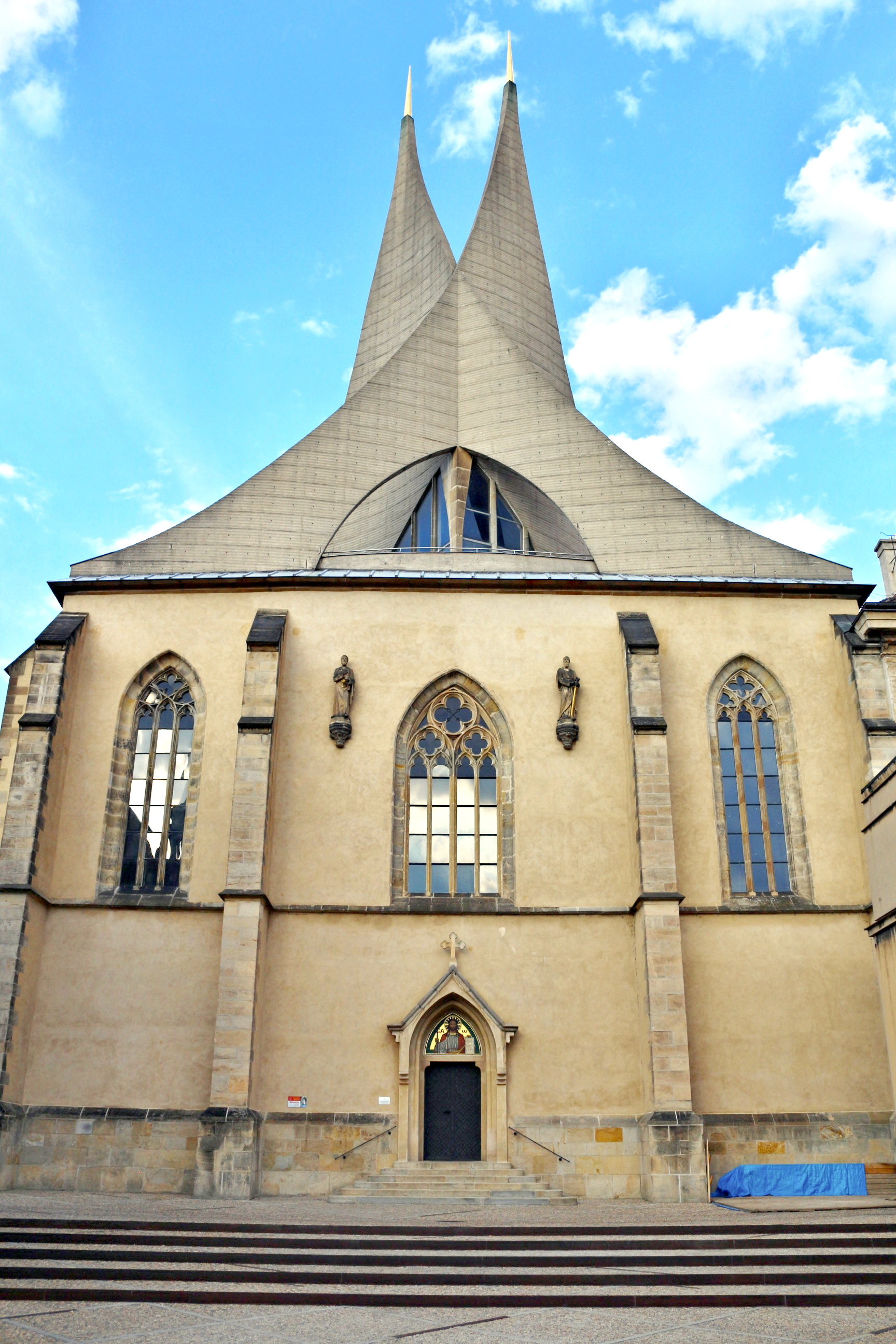- Your Online Prague Guide by locals – Follow us:
Emmaus Monastery Na Slovanech – Klášter na Slovanech – Emauzy

Church of the Virgin Mary Angelic (Kostel Panny Marie Andělské)
December 13, 2018
Holy Trinity Church (Kostel Nejsvětější Trojice)
December 13, 2018Emmaus Monastery Na Slovanech – Klášter na Slovanech – Emauzy

The unmistakeable modern white towers with gilded spires dating to the 1960s mark the Benedictine monastery Na Slovanech, whose original steeples were destroyed by fire in 1945 during a bombing raid. The church was founded by Charles IV in 1347 and became a centre of learning, art and Slavic literature. In the cloisters you can find the remains of priceless Gothic wall paintings; the Church of the Virgin Mary is painted in Beuron style.
The Emmaus Monastery is a national cultural monument.
Emauzy
- Vyšehradská 49 120 00 Praha 2- Nové Město


EMAUZY HISTORY
The Pope Clement VI granted the request of Charles IV (Karel IV) and gave his consent for a foundation of a monastery with Slavonic liturgy. The Emmaus Monastery, originally called the Monastery Na Slovanech was founded by Charles IV in 1347 for the Benedictine monks of the Eastern Rite brought in from Dalmatia and Croatia who used Old Church Slavonic as liturgical language. The intention of the emperor was to strengthen ties among the Slavs and contribute to eliminating the schism between the Western and Eastern churches. It was the only Slavonic monastery and the only non-Latin association in western Christendom of the Charles' empire. The monastery became a centre of learning and art. Students of Church Slavonic included Jan Hus, Jerome of Prague and others. A number of illuminated literary treasures were created here, including the Reims Gospel book (Remešský evangeliář). This book made its way from Constantinople, where it was brought by a Hussite mission, all the way to France, where it became a part of the French royal coronation treasure. The entire St. Jerome’s Vulgate, the official Latin version of the Bible, was first translated into Czech at the monastery
The monastery and its new church - a pearl of Bohemian Gothic architecture – were built nearby a small old parish church of Sts. Cosmas and Damian, which was allegedly built by Saint Wenceslas. The monastery with the church were finished and ceremonially consecrated by the archbishop Jan Očko of Vlašim at the presence of Charles IV, his son Wenceslaus IV and important guests on 3 March 1372. On that day, the gospel about Christ’s encounter with his disciples in the village Emmaus was read during the solemn consecration, thus the complex was also called Emmaus. As for the origin of the name, there is also an assumption which says that “Emauzy” was derived from Emmahouse (the house of Ema) which once should have stood at the place of the monastery and belonged to the nearby castle owned by first Bohemian Queen Ema, a daughter of King Conrad of Burgundy.
The building cost the same amount of money as the Stone Bridge (an original name for today’s Charles Bridge). The architect of the compound is unknown. The church of Sts. Jerome, Cyril and Methodius, Adalbert, Prokop and later theVirgin Mary has some architectural features and figurative themes reminding of the work of the court building workshop presided then by Petr Parléř. It also recalls his courage to build an unusual massive atrial building without towers, which was later displayed in the engravings of old Prague. The construction lasted 24 years, including the exterior decorations. In the left corner behind the altar there is a statue of sitting Madonna of Montserrat – Black Madonna. When the church was bombed in 1945, the statue as if by miracle was not damaged. It was taken to the Church of St. Ignatius in Charles Square and after the reconstruction taken back to its original location.
The wall paintings are among the rarest sights of Bohemian Gothic: the cloister – ambulatory– is decorated with paired painting, i.e. depicting scenes from the both biblical testaments. It’s kind of fresco, which is a European rarity and the most precious preserved monument of the Gothic period. In the 50’s, the frescoes were restored with a special technique, in Czech called “pekování”, which is making a net of hole scratches for a firm connection of the new plaster to the old background)The monastery passed all historical upheavals unharmed. During the Hussite turmoil, it went over to the Utraquists, the Hussite garrison was placed here thus it was spared of people’s anger and ruining. In the 16th century the abbot Matouš Benešovský converted it into a pub with a bowling alley and musicians for entertainment. In the early 17th century, the famous astronomer Johannes Kepler lived there for a few years.
After the Battle of White Mountain, Ferdinand III invited the Spanish Benedictines. They had the monastery and church thoroughly remodelled in the Baroque style, removing the high gabled roof of the church and replacing it with a tripartite roof. In addition, two low onion dome towers were added to the front of the church (1712).
After 1880, during so called Beuron period, the monastery and church were renovated and reconstructed for the needs of the Benedictine congregation in Beuron, southern Germany. They replaced most of the Baroque elements with a unique, austere Pseudo-Gothic style that is now called the Beuron style. Their music-loving abbot established a special, so called Beuron painting school and thanks to him the monastery became a centre of the Church Gregorian chant singing.
Before World War II the monastery was integrated into a new urban design of the embankment and the slope under the Emmaus by architect B. Hypšman, who also designed the monastery extension. The church was badly damaged during an American bombing raid on Prague on 14 February 1945. The Association for renewal of the Emmaus Monastery commenced securing work with a support of the citizens immediately after the raid. Damaged Gothic frescoes in the cloister were restored after 1947. In the following years a new reinforced concrete roof frame was built. The reconstruction works were entrusted to the prof. of CUT Oldřich Štefan. In 1964, a non-anonymous competition was held for an architectural design replacing the roof and towers of the destroyed church. The winning submission was made by architect F. M. Černý, who proposed using an entirely modern design instead of required towers and it was implemented under his guidance. Called couragé, his design is one of the most valuable examples of modern architecture in Prague: It is an asymmetrical 32 metres laminated dominant with a 40 cm thick white concrete construction. The construction has 4 meter high gilded spires with 1.3 kg of 24-carat gold. The spires reach the height of 52 metres and they measure 32 metres up from the moulding. The construction gives an impression that the southern steeple, which is closer to the River, is higher than the other one, but it is not true.
During the reconstruction and restoration work, the fragments of murals and inscriptions were uncovered in a chapter hall. An inscription written in Croatian Glagolitic (probably the text of the old Bohemian Ten Commandments from 1412) is the first and so far the only proof of Glagolitic epigraphy in our country or in any other Western Slavonic countries at all. On 1 October 1990, the friars came from Italian Norcia, the birthplace of St. Benedict, back to the monastery.
Source: https://www.prague.eu/en/object/places/212/emmaus-monastery-na-slovanech-klaster-na-slovanech-emauzy



